Reoccuring Elements | Common Pokegods | GSC Inspired
|
Other Sources |
Rumor Mill | Glitch-Related
The days of Red and Blue have come and gone. The games themselves have now been analyzed down to their programming code
and brought us to the point where there isn't much that we don't know about them. Some people may not realize it, but
there was a time when this level of of extreme access to information was not possible.
Back when the Red and Blue versions were first released, Internet and was young and as of yet unable to share
the information it does now. ROM hacking was virtually an unknown niche hobby, with many not even taking into consideration the programming that went into the inner-workings of a game. Pokemon itself had not yet taken off to the heights it has reached now for anyone to even consider diving into the game's coding in search of its secrets. Because of all of this, speculation easily arose about what lay hidden just beyond the borders of the game's set boundaries. What exactly was there just out of reach, in places that seemed to hold so much promise? What Pokemon may exist beyond the official 150? Perhaps there were secret Pokemon, some more powerful than any encountered in the main game and so rare that almost no one knew of them.
This type of speculation dominated the attention of the fan community for a long while, with debates raging about just what was true and what was false. Most importantly, did these "PokeGods" exist, and where could I catch one?
Nowadays it seems that if anyone mentions the "Pokegods" they get laughed off as a troll, or ranted at about how anyone that believed in them was an obvious retard. Many of the web sites discussing the PokeGods have long been abandoned or disappeared as the owners either learned more or just stopped caring about Pokemon. Because of this, when the newer generation of fans hear about these so-called "PokeGods" and go in search of information, they are only met with sites that haven't been updated in 10 years and those that react negatively.
It seems as though many Pokemon fans today want to just shrug off the early days of when everything was mysterious and Gold and Silver were just around the corner. To me, the whole "PokeGods" craze was an important part of Pokemon fandom that shouldn't simply be forgotten. I've decided to update this page as a way of salvaging and archiving some of the old codes for nostalgia, while at the same time examining them with a more serious approach.
 | What are the Pokegods? |
The PokeGods are (or were) as their name implies, supposedly god-like Pokemon that could find their
origin in one of four different categories:
Supposed evolutions of Pokemon that already existed
Misnamed MissingNo.-like glitch Pokemon
Pokemon planned for the Gold and Silver versions (or any species above 150)
Seemingly fabricated or just random
No matter which group a particular "PokeGod" fell into, almost all of them were claimed to be ridiculously powerful. It was
commonly believed that if you managed to obtain one, having it "faint" in battle would result in its actual death (meaning
it would die and you could never use it again). For this reason, it was often warned never to use one PokeGod against
another due to the risk.
The rumors and codes circulated to obtain such PokeGods were often ridiculously extreme or convoluted in such a way that it would take a person hours to perform and test out on their own. Due to the vagueness of these codes, one could never be entirely sure if they performed a code "correctly", which often times only lent towards a code's perceived truth, since if it was so difficult to perform, many people assumed they might actually be true.
The PokeGods seem to have appeared in three main waves, each triggered by different reasons and met with a different reaction by the fans.
The first wave was triggered largely by early beta and pre-release artwork for the Gold and Silver versions released in Japan, mostly from the Spaceworld game trade show. This art and sparsely translated information on the upcoming games was found by American fans while Gold and Silver were still in production and mostly unknown to the rest of the world (having been mentioned only very briefly in a Nintendo Power issue dating before the Red/Blue versions were even announced). In an effort to understand and explain this artwork, the concept of the PokeGods was born. Most of the PokeGods and their rumors at this time spread by word-of-mouth, later finding its way onto the Internet and spreading even further.
The second wave began due to the release of later pre-release artwork and information for Gold and Silver, this time directed at English-speaking audiences, as well as the appearances of new Pokemon in the movie Pokemon the Movie 2000: The Power of One. While this new information helped further some of the older rumors and establish several PokeGods, it also was the start of the end for the PokeGod phenomenon. At this time many people had been playing the Red and Blue versions for nearly two years, and information was readily-available that showed them just what Gold and Silver was. The new Pokemon, rather than being believed to be in the current games, were accurately believed to appear in the coming games. Because of all this, only a few of the new Pokemon were rumored as PokeGods, and even then the methods for obtaining them were limited.
The third and final wave of PokeGods appeared just before or after the release of the Gold and Silver versions. Most of these PokeGods were found only on compiled lists, and unlike previous PokeGods, many seem to have been entirely fabricated. Some sources indicate a few may be fan-given names for Gold and Silver Pokemon, though not enough are available for cross-reference.
How exactly did all this start though? Though the pre-release and beta artwork for Gold and Silver would seem to be the
dominating factor, the exact beginnings of the PokeGod phenomenon can actually be found in a much more official source: Mew.
Mew
Mew seems to be the original "Pokegod". The secret, super-powerful Pokemon that held a number greater than 150.
Though common knowledge today, to some Mew was just as "mysterious" as the other rumored Pokegods. With lack of
official sources, and even the Internet lacking much information on it, people's imaginations were left to wander.
Sure, there were the Nintendo contests, but a generally younger fanbase led into a lot of "what if's" which
turned into rumors and secret codes spread by word of mouth over the playground. These rumors would end up on the
Internet.
Mew under the truck
As is more or less common knowledge by now, a pickup truck can be found near the SS Anne if the player prevents it from leaving until Surf is obtained. This truck was the source of many rumors, the most popular being that there was some kind of way to move it, usually by using Strength. Generally, it was assumed that if one was able to move the truck, Mew could be found underneath it. This being said, the actual truck has no ingame use and could not be moved, presumably being there simply as a small easter egg for those who managed to get to the area (or even to intentionally fuel rumors..?)
Mew after the Elite Four
The assumption that Mew could be obtained by beating the Elite Four with certain requirements or a certain number of times.
Mew instead of the Diploma
This quite possibly could have been the longest believed "how to get Mew" rumor. Many people claimed that in the Japanese version, or in the English version (possibly with certain requirements being met), that Mew would be given to the player in the place of the diploma which is awarded for completing the Pokedex. Since this was easily proven false, it was often claimed to be "only in the Japanese Blue version"
| 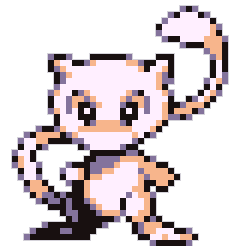 |
Even though none of the rumors actually worked, there was no denying that Mew actually existed, its appearance in official media (screenshots, movies, etc) being solid proof of this. What is interesting about this rumor is that it started the trend of claiming "It was in the Japanese version", which for some reason made sense and furthered the mystery for a lot of people. (this was echoed in real life in Crystal with the removal of the Celebi event) Along the way kids would imagine, "if Mew is real..then what ELSE?" It is quite possible that the other Pokegods codes stemmed from the original 'Mew codes' in this way.
 |
|
Though not Pokegods themselves, there were common archetypes and elements shared by many of the codes.
These elements were present in nearly every code, with other elements and codes sometimes being referenced.
These elements were quite likely the most popular seen, which inspired others to emulate them in new codes.
This resulted in a type of foundation for what a "good" code would be made up of, with any that did not
adhere to these elements usually perceived to be a fake and left to fade into obscurity. These elements are the following:
Mr. Psychic
A popular belief was that if you put the Legendary birds in your party in order along with 3 Geodudes, Mr. Psychic (the guy who gives you TM29) would tell you about the Pokegods. This was pretty consistant, except that sometimes it was said that you also had to have all 150 Pokemon, and other times the Geodudes were not required.
Many sites said that having Mr. Psychic tell you about them was an "access code" that had to be done before any of the other codes would work. Why people believed that Mr. Psychic knew something about the Pokegods in the first place is unknown. None of the codes could actually get him to tell you about them, or anything different from what he would normally say.
Bill's Secret Garden
Several of the Pokegods codes involved finding a way to go behind Bill's house and into his garden where rare Pokemon supposedly lived. Some variations referred to it as "Bill's Mountain" or "Bill's Forest" (in one version he even had a plane >_>). This belief most likely came about due to there being an empty space behind Bill's house (instead of being filled with trees, etc) that can easily be seen by the player while walking in front of it. Similarly, though not as popular, there were also rumors about the inaccessible grass on the east and west sides of Pallet Town, most likely for the same reasons.
The PokeGods City
Pretty short and simple, there were several codes circulated that told of hidden cities where people had the
PokeGods and would willingly trade them for common Pokemon. Popular names for this type of city were Cloud City,
the PokeGod Factory, Pokemon/PokeGod Island, and Brick Town.
Other names were thrown around, though they weren't nearly as popular. These cities often differed in what you
could find there, but all shared the supposed presence of PokeGods and being able to obtain them easily there.
Most versions of these codes said that you had to beat the Elite Four a certain number of times, after which
Prof. Oak would show you to the city. Possibly the archetypical example went as follows:
|
There are such things as pokegods. To get them beat the Elite Four 30 times without talking to anyone in between the nurse in the pokecentre at Indigo Platue or what ever it is, and the riv . On the thirtith times Professer Oak will say "I'm getting tired of this" and he will let you walk around the hall of fame which leads to a new city where people will swap pokegods.
|
It should be mentioned that what appears to be a typo ("and the riv .") was copied almost every time the code was reposted. It was occasionally corrected to "river" but it was most likely intended to be "rival". The original version without the "riv" typo seems to have been lost.
Professor Oak's Gift
Often seen in combination with the other types of codes listed, it was common to claim that particular Pokegods or items (such as his 'custom Pokeball') would be given to you by Prof. Oak after fulfilling some sort of requirement. An interesting point is that in later generations the various researchers do give you rare Pokemon after completing certain tasks.
Secret HMs
Like the Elemental Stones, HMs beyond the official five were said to exist in the game. No matter what their exact
function was, their purpose was always for entering usually inaccessible areas. These areas were also usually
"PokeGod Cities", as detailed above. Coincidentally in later generations, some HM's very similar to those mentioned in Pokegods rumors were introduced (Dive and Rock Smash being good examples).
Catch 150 Pokemon
Many codes were only said to be possible after completion of the Pokedex (first 150), which was said to be a sort of
access code similar to Mr. Psychic and often paired with that access code as well. Some variations said you needed
151 Pokemon (with Mew), 152 Pokemon (usually Pikablu), or some other random amount of PokeGods on top of the official
150.
This type of rumor saw reality in Gold and Silver and the later games in the series, where the player could receive
a rare Pokemon, such as a starter, upon completing their POKeDEX to a certain number. This was implemented in
conjunction with the "Professor Oak's Gift" type of code.
Mist Stones
The Mist stones were a type of evolution stone believed to be capable of evolving every single Pokemon, even those
which were already at their final stage of evolution. This stone was said to be found in the Seafoam Island after
collecting every item in the area, then using the Itemfinder on literally every tile. Though it was initially said
that there was only one Mist Stone, the rumor spread and it eventually became the catch-all secret stone that we
know today.
Other secret stones were said to exist, with each evolving a specific Pokemon rather than being capable of affecting
any. These stones were typically said to be obtained through use of the same method to obtain a Mist Stone, but in
different areas.
"Do this x Times.."
Beating the Elite Four x amount of times, talking to certain people x amount of times, or use of elemental stones x number of times. The numbers could vary dramatically and were usually very high. One reason this 'genre' of code may have been so popular is because if the numbers are very high, it is difficult for someone to disprove by personally testing.
 |
|
|
With most information being condensed onto a few large websites, it's easy to forget how things were in the past. While there always were larger, more dominant sites, but unlike today, these large sites were accompanied by thousands upon thousands of smaller personal sites. Any random kid could sign up for an account on expage (which was simplified and did not require much if any HTML knowledge) geocities, xoom, or one of the other popular web hosts to let the world know whatever they had to say about Pokemon.
Though there was no real structure, a sort of community was built through these types of amateur websites. Owners would compete with each other for hits, and would often offer different codes as a reward to visitors for reaching a certain benchmark of views or receiving a certain number of votes. While these codes may have occasionally been made up on the spot, the vast majority of them were copied and pasted directly from other websites, webmasters being able to "get away with" this because of how shoddy search engines were at the time (it was often easier to find sites simply by navigating other site's links and affiliates rather than searching). This practice was not limited to individual codes, though. Lists of Pokegods and and entire lists of different codes were also copied word for word, typos included, most of the time being left in the same exact order. This became the fashionable way of filling out a website for the lazy webmaster. Because of the different codes and lists being copied and pasted between hundreds to thousands of sites, this makes it very difficult if not impossible to tell where most of them originated, but also makes the canon of Pokegods 'mythology' strangely consistant.
|

backgrounds and gifs were also circulated
|
|
|
One example of these practices is the site created by a guy called "JustinMew". His website was pretty run of the mill for its time and contained various "information" on Pokegods as well as fake screen shots and things ripped from other sites that specialized in making up fake Pokemon. Even though many of the screen shots were very obviously edited, had sprites that hardly matched the style or color palette or were never intended to fool people, there were still people who saw them on this site and others like it and assumed they were real.
What really didn't help the situation is that many people, including JustinMew himself (who told me he made the stuff up) flat out lied about having captured or seen the Pokegods. This being said, it wasn't only JustinMew or site owners in general doing this. You could go to just about any forum and there would always be a handful of people who claimed to have captured this-or-that Pokegod. (I mostly use JustinMew's site as an example because I talked to him and we used to know each other.)
*and because some people seem to get the impression from this that JustinMew was some kind of Pokegods expert, I want to point out this was NOT the case. His site just happened to be popular. He didn't know any more than me or anyone else, he was just someone who spread rumors that were already being circulated. In fact... he contacted ME looking for information through an earlier version of this very site. And he also doesn't even like/play/care about Pokemon any more, so it will do you no good to try and contact him.
Pokemon Factory
There was a website called "Pokemon Factory" which created fake screenshots of Pokegods and other made-up Pokemon, not necessarily with the intent to fool anyone. Even though these images were watermarked and obviously fake, many became widely circulated and contributed a lot to the spread of Pokegods rumors (sometimes being used as 'proof' that they existed).
The following are the names of different Pokegods that were being circulated, I have tried to group them appropriately. (for now I might have some of them in more than one category) Keep in mind that this is by no means a complete list. It should be noted that while the list of Pokegods is fairly large, many of them did not have as much fan 'mythology' around them and were known by name only.
 |
Evolutions of Pokemon that already existed
|
With a few exceptions, these seem to come from the idea that one could find the mist stone which was able to evolve every single Pokemon. Mewthree is a bit different because people also thought that pictures of Mewtwo wearing armor from the first movie was Mewthree... (detailed below).
Flareth is also an interesting case because of all the Eeveeloutions, it was the only one that was thought to evolve again (or at least, the only one that was so widely circulated)
|
Venusaur | > | Sapusaur/Sapasaur
|
Charizard | > | Charcoalt/Charcolt
|
Blastoise | > | Rainer
|
Butterfree | > | Locustud/Locustod
|
Beedrill | > | Beepin
|
Raticate | > | Raticlaw|
Nidoking | > | Nidogod|
Nidoqueen | >
| Nidogoddess/Nidogodess|
Golduck | > | Pearduck|
Sandslash | > | Sandswipes
|
Hypno | > | Dream Master
|
Onix | > | Dimonix
|
Gengar | > | Spooky|
Flareon | > | Flareth/Flarith|
Eevee | > | Lunareon|
Eevee | > | Solareon|
Omanyte | > | Omnamist|
Mew | > | Corona Mew*|
Mewtwo
| > | Mewthree
| | | | | | | | | | | | | | | | | | |
*(also called Cyro Mew, Chrona Mew, Chrono Mew, Crono Mew, or Cyber Mew)
Mewthree
While most PokeGods evolved from common Pokemon, and a few from uncommon or rare Pokemon, Mewthree was one of only two PokeGods rumored to evolve from a Legendary. This is unusual, as it would make sense for evolutions of legendary Pokemon to be more popular due to their relative small number at the time. The fact that only Mew and Mewtwo had any sort of official background may be the reason why they were chosen over the other legendaries to have their mythology developed further under the pretense of the PokeGods.
Mewtwo quickly fostered popularity for one reason: it was the most powerful Pokemon legally obtainable in the game. At a time when Mew was still largely whispered rumors, Mewtwo was a bonus Pokemon you could actually see and even catch. It became a rite of passage and instant fame for anyone to complete the game and encounter a Mewtwo, then add it to their team and show it off on the playground. With a Mewtwo's stats alone beating out many Pokemon, combined with its moves and psychic typing, any team would be near-unbeatable. It was simply so powerful that there was no competition-even more so since "real" competitive battling was even less known.
However, rumors soon began to crop of up of a Pokemon even more powerful than Mewtwo. People rationalized that since there was already Mew ("Mewone"), and a MewTWO, there might likely be further numbers of even greater power. Compounded with Mewtwo's already-mysterious origin in the game, the idea of a "Mewthree" became a popular notion.
While the idea of Mewthree briefly coincided with Mewtwo's armored appearance in Mewtwo Strikes Back, it should be noted that the two aren't mutually exclusive. Rumors of Mewthree continued on (albeit less widely-believed) as they did before the movie, while the armored Mewtwo seen in the movie developed its own rumors on how to evolve Mewtwo into that form, which usually had names other than Mewthree to describe it. (More on Mewthree as inspired by the anime can be read under the "From other Official Media" section)
Although Mewthree was the most popular rumored evolution of Mewtwo, there were other rumors for a Mewfour and even higher, though those were typically ignored as too ridiculous to be believed. An evolution with the name "Altanes" was also mentioned which carried a little more weight than the others, but its connection (if any) to Mewthree is impossible to determine.
Flareth
Flareth is an interesting case, since out of all the Pokegods believed to be evolutions of existing ones, it was the only one commonly believed to evolve from an "Eeeveeloution" and not Eevee itself. Though one would logically assume since it was praised as being "The evolved form of Flareon" that using the Mist Stone on a Flareon would produce it, there were not actually any codes stating this or that required one to already have a Flareon to be evolved. No, Flareth was simply given to the player as if it was a "basic" of itself and unrelated to any others.
This sort of contradiction could have its roots in a possible origin of Flareth: Pikaflare. Or more specifically, the Honoguma artwork. While the name does not seem to have been commonly circulated accompanying the artwork (which wasn't that well circulated to begin with), it's very possible that this discrepancy in its fabled "origin" in comparison to how it's actually obtained could come from it being an alternate name for Pikaflare/Honoguma, which somewhere along the line became an entirely seperate Pokemon. If this is the case, it is likely that once this distinction was made and the connection lost, it was later attributed to being a Flareon evolution due to the "flare" in its name and the popularity of "evolved from" Pokegods.
Codes for obtaining Flareth generally involved talking to the thirsty girl in Celedon with Moltres or several Moltres in one's party (usually 3). Sometimes an additional part of the code stated that you needed to go to the Unknown Dungeon and use the item finder and locate something (as seen in other codes) before talking to her.
Dimonix
|
|
"Dimonix" (sometimes "Diminox", "Dimondox", "Dmonix", or "Dimanonix") was a rumored evolution of Onix. It had the most variations of name than any other PokeGod, making it difficult to tell which was the original or most circulated version. However, all variations more or less indicate that this supposed evolution was composed of diamonds. For the purposes of this article, "Dimonix" will be the name used due to no reason other than personal preference.
Dimonix, even counting its numerous names, was not a very popular or well-circulated PokeGod. References to it could often be found only on sites that didn't copy-and-paste whole code-lists wholesale. While this seclusion undoubtedly aided in Dimonix having a lack of publicity, it also resulted in the many variations of its name and code. This was likely due to site-owners writing the code down from memory after not being able to find it again.
|
While there were many variants, Dimonix only truly had one code. However, it was also prone to variation and would often be worded differently with each instance, though the basic method of the code remained a constant: A level 60 Onix would have to be traded for a certain number of times. Usually the Onix would have to be traded with another level 60 Onix, with the number of back-and-forth trades being 4, 6, or "a lot".
|
A few variations of this code added a short description of how Dimonix looked, with one suggesting it would have horns and another (possibly later one) wings as well as horns. This description could be found under a variation that used the name "Dmonix", which can be pronounced as either "De-men-ix" or "Dem-on-ix" (similar to "Demonic", but with an "x" end). This pronunciation is likely the source for the demonic appearance of horns and wings.
Why exactly Onix had a PokeGod evolution at all is unusual in itself and calls to question its origin. Onix wasn't a particularly popular Pokemon, which begs the question why anyone felt it needed an evolution. As evidenced by several of the other PokeGods discussed on this site, many PokeGods were initially inspired due to official sources, popularity, or third-part sources. As just stated, Onix wasn't very popular, so we are left with two possible origins for Dimonix. Each will be discussed with points supporting and opposing their likelihood, though neither are entirely conclusive.
The most likely origin of Dimonix is the Pokemon Factory, which introduced a sprite showcasing a fake Pokemon of the name "Diminox" sometime in 1999. This sprite (as seen above) depicts a golem-like rock monster that was likely taken from an RPG game. The code for Dimonix was being circulated as early as May of 1999 (though possibly even earlier), so the years at least coincide. For many people, this sprite is the exact origin that inspired the evolution for Onix. However, the two look nothing alike and the Pokemon Factory itself assures us that if one of their fake Pokemon shared a name with a PokeGod, it was because the code inspired them to create it, not the other way around.
Another possible origin for Dimonix (this time from an official source) is the Crystal Onix appearing in the anime. While made-up of a different mineral, a younger viewer would easily be reminded of the more well-known diamond and believe that that was what the Crystal Onix was. The anime certainly was responsible for the introduction and popularity of several Pokemon before, so briefly causing interest in Onix in such a way where a "secret" evolution might exist is one of the more plausible origins for this PokeGod. However, like the Pokemon Factory as an origin, this, too, is called into question.
|
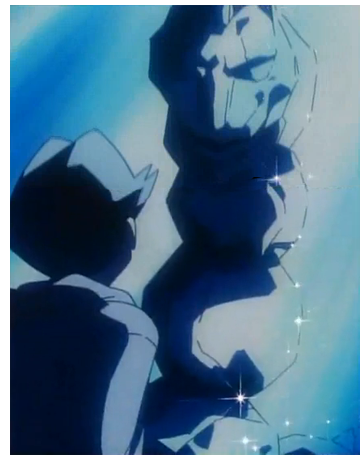
|
The first broadcast of The Crystal Onix in the United States, which featured the Pokemon, was February 5th of 2000. This is over half a year after the Dimonix codes were being circulated. One could argue that the PokeGod was inspired by the Japanese broadcast of that episode, which actually did precede the rumors by several months, though this is considered unlikely due to the relative "foreign media policy" Japan held at the time. The episode simply couldn't be seen earlier than when it was broadcast in the US due to the lack of inter-cultural media sharing. So is this possible origin debunked? Probably not. But its validity is certainly questioned, which only serves in continuing the mystery of this particular PokeGod.
All this aside, Dimonix largely stands out for one reason: its similarity to Steelix. While most codes for PokeGods at the time required the Mist Stone or simply catching them, Dimonix was one of the few PokeGods involving actual trade with another game. Comparing this with the actual method for evolving an Onix into a Steelix, one of the few Gold and Silver Pokemon to evolve upon trade, it seems like a strong coincidence. In fact, one site even name-switched two of the original Dimonix codes with the name Steelix. However, it is unlikely that Dimonix was ever inspired by Steelix, and that this one site simply believed they were "updating" the code.
 |
Seemingly fabricated Pokegods
| |
While most PokeGods were believed to evolve from a previously-existing Pokemon, a few seemingly have
neither a connection with any of the original 151 Pokemon nor a basis in the coming Gold and Silver Pokemon.
These PokeGods usually have the most difficult or confusing methods for being acquired, as well as vague
implications of their own mythology. This is especially unusual considering many of the PokeGods were
never mentioned outside their own codes, yet were presented as if they are familiar to a wide audience.
While the reasoning for this is unknown, it is likely that this was mainly a tactic used by their creators
and spreaders to instill some sense of sincerity in their existence.
*Due to our continued research on the PokeGods, many PokeGods once found in this section have
been found to have legitimate origins and were moved to the appropriate area. With this in mind, please
realize that some of the PokeGods believed to be completely fabricated may actually not be. If any
evidence arises suggesting they are not, then they will be moved as well.
Tricket
I have to say I wasted many hours trying the supposed "official Nintendo approved Tricket code" that was floating around. This code is particularly interesting in that in nearly every instance of it, it remains exactly the same-word for word.
The code went as follows:
This code is for TRICKET! a new Pokemon for Gold/Silver.
First, you must carry ALL 6 BUG POKEMON in your party in this order: Caterpie, Metapod, Butterfree, Weedle, Kakuna, Beedrill.
Then, open an empty box in your PC without any Pokemon in it. Go into the Safari Zone and catch a wild Venonat and a wild Venomoth. You cannot catch Venomoth before Venonat.
Then, catch a wild Paras and a wild Parasect. Same rule applies for Parasect not before Paras. Keep them all in your PC box and do not change for any new ones. You do not need Scyther or Pinsir because they are rather rare to find. You'll see them on the Victory Road, however, by catching all of the other bug Pokemon. That's a pre-code.
Yes, along with Scyther in Red, Pinsir will be in Red too, and along with Pinsir in Blue, Scyther will be in blue! It's the truth. Beat the Elite Four all the way through with the 6 Pokemon told. Do not allow Caterpie, Metapod, Weedle or Kakuna to continue to evolve, just press B to stop them from evolving.
Its best for them to be on high levels. Such as L50 Caterpie and Weedle, L60 Metapod and Kakuna and L75 for Butterfree and Beedrill. You can use Rare Candies and Gameshark to boost them up. After you win all five(Gary too) matches, Professor Oak notices you have all your Bug Pokemon. He asks if you're a bug collector, YES or NO. If you answer NO, he says, "my mistake" and then the Hall of Fame comes up. If you answer YES, then, he takes you a cage where TRICKET the CRICKET lives! He lets you take it and use it for future battles.
Tricket is on Level 65, the same level as Gary's final Pokemon. Tricket knows Spore, Twineedle, Mega Kick(crickets like to kick their legs) and Sing. I do not know if it learns any moves. It has no link with Shadybug. Shadybug is an entirely different Pokemon. They're just bug pokemon.
|
Now keep in mind, I actually TRIED this code multiple times, even though there is one major flaw in the way that it's written that gives away that it doesn't work. That particular flaw being the fact that it requires you to have a party full of bugs and still make it to the Elite Four. While it is possible, the only way to do it is to make sure the last Pokemon center you healed at before starting was the one at the Indigo Plateau, and then use an escape rope in any random cave.
You'd think that would have been enough of a tip off to me, but at least I can testify that I have actually tried this... More than once (granted, I was 12 at the time) and trust me, trying to find those Pokemon in the Safari Zone in that order takes FOREVER >_>
Another interesting thing about this particular code is the fact that even the few sentences at the end about "Shadybug" were always copied with it. This was generally ignored by most people, as there were no wild stories on how to capture 'Shadybug' or any other details at all relating to it. The name "Shadybug" apparently originated from a more obscure list of Pokegods which was being circulated. Of the two versions of the list, a later one included short descriptions of each Pokemon and described Shadybug as "A bug that protects itself with a leaf". Tricket was listed directly after Shadybug in said list, described only as being the evolution of Shadybug. Since there are no actual images or other basis for either Pokegod, figuring out how/why this was apparently debated is a bit fuzzy.
Merged Pokegods
|
One type of PokeGod often seen mentioned were those supposedly obtained by merging several lesser Pokemon or even several
PokeGods into one new creature. The codes varied, with most involving steps to merge the Pokemon, while others were said
to be encountered without any active merging on the part of the player. Others simply could be obtained through use of a
Gameshark code.
It's difficult to be certain which, if any, of these type of PokeGods were intended to be anything but a practical joke.
While some are clearly more outlandish (as you will see), others appear to be perfectly sincere and have codes just as
thought-out as many of the other, more established types of PokeGods.
The two most notable merged Pokemon are Venustoise, which appeared in the anime, and Zapmolcuno, which appeared in the Pokemon Special manga (as seen to the right).
It is likely that these two official appearances of merged Pokemon fueled speculation into the possibility of other merged
Pokemon in the games.
| 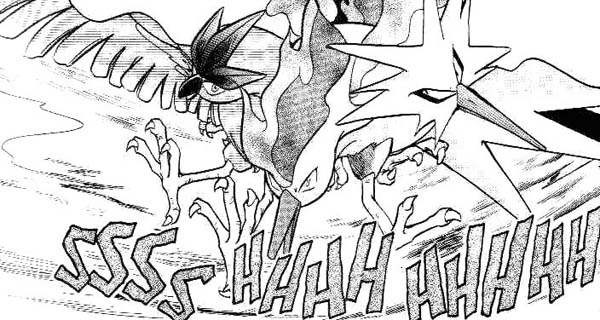 |
Zapmolcuno in particular may have been the original source of most of these rumors, due to the unusually
large amount of codes for merging the three Legendary Birds either with each other or other Pokemon.
A list of some of the most popular and unusual merged Pokegods can be found here.
As is still done with Pokemon games today, before the gold and silver versions were released in Japan there were pictures of a select few Pokemon that were released to the public and were floating around the Internet.
Pikablu (Marill)
| Marill, under the name "Pikablu" or "Pikablue" (sometimes "Ketoblu", "Mew Mouse", or "Metamouse"), held the distinction of being the first true PokeGod
that had a substantial mythology of its own. After Mew, it was without a doubt the most well-known and sought after PokeGod.
Pikablu was thought to be a Water-type or Ice-type evolution of Pikachu or Raichu (depending on the source) and could
have god-like abilities typical of the PokeGods or simply be a hidden, bonus Pokemon; this also depended on the source.
As its mythology grew, Pikablu eventually surpassed its origin and the connection to Pikachu was seemingly dropped in
favor of it being a stand-alone, unevolved Pokemon. This becomes clear when later mentions of Pikablu dropped the Electric-typing that connected it to Pikachu.
It's interesting in itself that Marill was almost entirely known as "Pikablu" in America. Apparently, its Japanese name,
Mariru, had been released in English and kana at the same time as its artwork. This was ignored in favor of the "Pikablu" moniker, likely due to the Pokemon's close resemblance to Pikachu and its blue-coloration (pika(chu) + blu(e) ). Even as time went on and the official American name spread, "Pikablu" held sway due to preference and old habit.
| 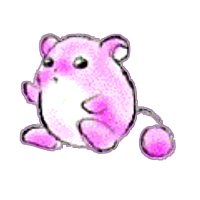 |
One common theory as to why the name "Pikablu" arose was that soon after the release of the original Red and Green versions,
artwork for Marill was leaked either accidentally or intentionally by someone at Gamefreak. Some person at Nintendo
(of America?) then saw it and coined the name "Pikablu" to describe it for lack of a released name... Or so the story went.
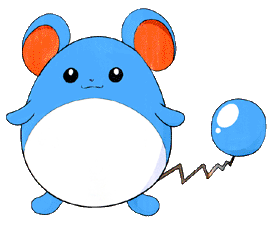 |
It should be noted that this story is unlikely considering the earliest known artwork for Marril was not leaked, but
officially-released at the Gameboy Spaceworld convention in 1997.
Aside from this fact, the artwork shows Marill with a pink or purple-coloration rather than the final blue, and the name
was still provided in script as "Mariru".
While the origins of Pikablu may seem simple, it should be realized that at the time of Marill's introduction and Pikablu's evolution from it that the Internet and the children browsing it interested in Pokemon were still young. Information was difficult to come by, with search engines being in their infancy and as of yet unable to provide full search results. Even though Marill's Japanese name would be provided alongside the artwork, and full coverage of what Gold and Silver and Spaceworld was, those that saw it were too young to be able to understand what the Japanese meant. The Internet was too young as well for them to easily contact others to ask what it meant. Combined with the imagination of children, what little amount of information that could be found and understood easily mutated and exaggerated itself into something far grander.
As time went on and speculation of these "new" Pokemon evolved into the concept of PokeGods, Pikablu took the forefront
and began to take on a new life. Rumors began to pop up on what exactly a "Pikablu" was, with the most common explanation being that it was a secret evolution of either Pikachu (the Pokemon it most resembled) or Raichu. It was only a matter of time that "evidence" arose in support of this theory.
|
|
In the American Red and Blue versions, there is a particular NPC found on Cinnabar Island that says something unusual if you trade him a Raichu for an Electrode. If you make the trade, then leave the building and return, he will say "The RAICHU you traded to me went and evolved!". (As seen in the screenshots to the right) The rumors instantly garnered some sense of legitimacy to them, with many claiming this was "evidence" that Raichu does indeed evolve, and, logically, that that evolution must be Pikablu.
Unfortunately for those arguing the presence of Pikablu in the game, the text was eventually revealed to be the case of poor translation. When Pokemon was localized for the United States, Nintendo of America used the updated Japanese Blue version as a base that was then divided into our Red and Blue versions. In the Japanese Blue version the two Pokemon traded were not a Raichu and an Electrode, but a Kadabra and a Graveler, which do evolve. Upon dividing the Blue version into the Red and Blue we know, the Pokemon traded were those appearing in the Red and Green versions (Raichu and Electrode), while the Blue version text referencing evolution was still used. This error would ultimately mislead many and help bulster the already-growing rumors.
| 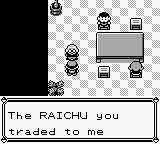 |
This supposed evidence was so widespread and well-known that it even received mention in the official Nintendo Power magazine. When the NPC's statement was written in for confirmation, the Nintendo Power editorial staff simply said that it was incorrect.
As time went on, there became no doubt in the minds of the young Pokemon fans that Pikablu was real. Unlike most of the other PokeGods, Pikablu was inspired by an actual Pokemon, and because of that there were official references to it. Seeing these references hardened the belief of many that Pikablu was out there somewhere.
The first of these official references came during the summer of 1999. A "special music video" was shown on Kid's WB as a promotion for the 2 B.A Master Pokemon CD. This video was created for the song "What kind of Pokemon are you?" and contained scenes from the Pikachu's Summer Vacation short, even though the movie had not yet been shown in America, and none of the GS Pokemon featured in it had been announced. This gave even more exposure to "Pikablu", which was not mentioned by name, but shown in both the music video and the commercials preceeding it. Even though name "Pikablu" and countless codes were already in circulation by this time, the video was significant because it was the first solid proof for many that this blue mouse Pokemon--whatever its name actually was--did indeed exist. This considered, there was still the lack of an official name or any other information, encouraging the rumors to continue.
|
|
Later on, as more official references to the coming Gold and Silver Pokemon were released, belief in Pikablu slowly diminished. Rumors of Pikablu adapted and the PokeGod shifted from being believed to be in the current games to being one of the many PokeGods presumed available in the sequels. Many fan sites were closely following the updates on Gold and Silver and publishing what information they could, as well as speculation of their own. It was at this time that Marill's Japanese name, Mariru, became commonly-known. Past beliefs still held sway, however, with these same sites suggesting that "Pikablu" would be its American name.
It wasn't until Pokemon the First Movie: Mewtwo Strikes Back that belief in Pikablu finally reached a sudden stop. Marill was widely advertised to make its official debut in the "Pikachu's Summer Vacation" short playing before the movie, with pre-release screens on the Internet and trailers both highlighting the new Pokemon. Many people cried out "I knew it!" and excitedly awaited the movie to see "Pikablu" at last.
Imagine the young fans' surprise as the short specifically identified the Pokemon as "Marill", and, while a skilled swimmer, was nowhere near as powerful or rare as once believed.
|
Dissapointment was heavy with many, while others immediately took to their sites and vehemently declared that it was NOT Pikablu, but Marril (as the name was spelled at the time), and that anyone that continued to use the old name was very much incorrect.
It was this event that suddenly shook many away from their pre-conceived notions. With "Pikablu" an incorrect belief, then what else might be as well? As simply as it started, Pikablu faded away and in the minds of many was nothing more than a common Pokemon.
While the name "Pikablu" is still occasionally used, it is met with vague amusement or irritation. The origins of the once widely-sought "PokeGod" became muddled and many simplified it as "childish stupidity". This assessment is an unfair and naive assumption, as perhaps no Pokemon other than Mew has garnered so much speculation and attention from both official sources and the fans. To overlook the history of Marill before it became Marill is ignoring an important part of what it means to be a Pokemon fan. The sense of wonder and excitement over a new Pokemon, and speculation of what it's "all about" is a defining feature of the fandom to this day.
Information relating to codes on how to obtain Pikablu can be found HERE.
Pikaflare (and other Pikachu/Pikablu Clones)
|
"Pikaflare" or "Flarechu", was a supposed Fire-type PokeGod said to evolve from either Pikachu or Raichu.
While it wasn't widely rumored or popular, Pikaflare is notable for two things: first, being the first
Pikablu-inspired clone of Pikachu of another elemental type, and, second, for most likely being based off
of or drawing inspiration from the beta GS artwork of an intended Fire-type starter known as Honoguma
(referred to by some as a 'beta Cyndaquil').
While the image of "Honoguma" did exist on the internet at the time, curiously, it was not that
widely circulated. This leads to a situation similar to that of "Mewthree" in that while the name
and concept for "Pikaflare" may have been initially popularized with this artwork, it later became less
associated with this image (which many did not even know of) and known mostly by name only with
no specific depcition. Because of this, other names such as "Pikared" or "Flarachu" popped up
but may or may not have had anything to do with the Honoguma artwork ("Pikared" in particular).
Because of Pikablu having such a big influence, it was only a matter of time before rumors began to crop up of another
"Pikachu". With Pikachu as an Electric-type, and Pikablu as a Water-type, the most logical choice for a "new"
Pikachu was a Fire-type. An Electric-Water-Fire trio was already seen with the three Eevee evolutions and the Legendary
Bird trio (though Articuno was Ice). Some people even went so far as to believe that Pikachu, Pikablu,
and Pikaflare were a new trio planned for Gold and Silver. Taking this into consideration, the conclusion
of there being a "Pikaflare" or "Pikared" was inevitable, with or without the Honoguma artwork as a basis.
|  |
Houou (Ho-oh)
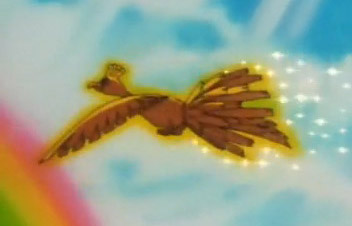 
|
"Houou", alongside Pikablu and Togepi, was one of the first PokeGods to be widely rumored and more importantly, believed. The reason behind this is because similarly to Pikablu and Togepi, "Houou" was inspired by an actual Pokemon (in this case Ho-Oh) that appeared in an official source.
Ho-Oh was first seen as an unidentified golden bird flying towards a rainbow at the end of the very first episode of the anime. Since no name was provided, fans began to refer to it as either "Rainbow Bird" or "Golden Bird", though by some people it was believed to be MissingNo. It wasn't until much later, when more information on the Gold and Silver versions began to be released, that the Pokemon took on the Romaji-translated name of "Houou".
Despite being the first Pokemon of the Gold and Silver versions to be seen by American audiences, Ho-Oh would not become a PokeGod in popular opinion until later on. This is due to the initial air-date of the anime in the US, which was only seven days before the games were released. Those that had played |
Red or Blue would not yet have been able to advance too far into the games to really see what Pokemon they held. This short time-difference resulted in very little surprise at the sight of the golden bird Pokemon, as many simply assumed it was another Pokemon they would encounter later on.
However, as time passed and the games were played through (and in some cases beaten), people began to realize that the golden bird didn't seem to actually be in the games. Attention returned to the mysterious Pokemon as many began to wonder what exactly it was and where they could catch it. As the Gold and Silver versions had yet to gain sufficient coverage to be widely known about, many people couldn't comprehend that Ho-Oh and the other newly-introduced Pokemon would be found in sequels rather than Red and Blue. After all, Americans had only just been introduced to the games, so they had no reason to expect sequels. In reaction to that, players simply assumed that Ho-Oh was hidden somewhere in the games and needed only be found.
|
Since Ho-Oh wasn't actually in the games, and with no official information on it that Americans could readily find, people began to develop theories to try to explain what sort of Pokemon it might be. The most popular of these theories was that Ho-Oh was some sort of hidden "fourth" legendary bird alongside Articuno, Zapdos, and Moltres.
Furthering this "legendary bird" presumption, Ho-Oh's golden and red appearance led many to believe that it was a Fire/Flying or Psychic/Flying evolution of Moltres. This connection to Moltres, however, was not very widespread. Ho-Oh being presumed to be an evolution of Moltres was likely simply the rationale for why there would be another Fire-type "legendary bird".
Other than its status as a rumored "fourth" legendary bird, Ho-Oh had one other common belief associated with it. In many references to the Pokemon, people would offer the possibility that "Houou" could be found in the Green Version of the Pokemon games. The Green version of Pokemon had already been rumored to hold many secrets left out of the American versions, so including Ho-Oh among them was a simple enough presumption. This idea would also likely have been fueled by the retrospective consideration people gave to Ho-Oh after they realized it wasn't in Red and Blue. Again, Gold and Silver was far over the horizon and largely unknown by everyone... But the Green version had already become popular as the "lost" third game to Red and Blue (this was before Yellow), so it was perfectly reasonable for people to place Ho-Oh there. |
 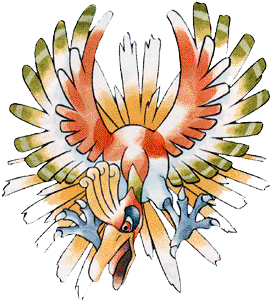 |
As time went on and coverage of Gold and Silver began to become commonplace in publications, new images of Ho-Oh began to be seen. For the longest time the only visualization people had of the Pokemon was its short appearance in the first episode of the anime, which would only have been seen once by most people as the series had yet to reach a point of re-runs. It was now that people could finally put an image the Pokemon they'd long speculated on.
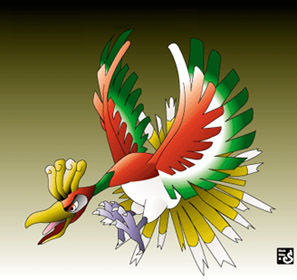 
| |
Any information of Ho-Oh on a fansite was bound to have one of two images: the "in-flight" image as seen to the left, or the official artwork as seen above. The first image, of Ho-Oh flying, is of questionable origin. The coloring suggests it may have been fanwork, or a re-coloring of something official. It was less widespread than the other image, though it could certainly be seen on a casual search.
The other, official artwork, was mostly a scan taken from its printing in the Nintendo Power magazine. While its possible the image or another version of it could have been taken from the Pokemon.Com website or a Japanese site, many instances of the image include a Nintendo Power watermark or other indicating information. At the very least, the image was taken from Nintendo Power's website.
In the end, Ho-Oh's position as the PokeGod "Houou" is one of the more rich histories. While it didn't have as many codes or popularity as some of the other PokeGods, it did have a mythology that rivaled even those of Mew or Pikablu.
Ho-Oh was the first "new" Pokemon many people saw. It was known and rumored even before Mew. Its status as the first new Pokemon is often overlooked by people today, with many not |
realizing that it helped foster the PokeGod phenomenon nearly as much as Mew. Both were instrumental in creating the sense of mystery and "something hidden" that made Pokemon so popular. Because of this, it's fair to say that Ho-Oh is one of the most important Pokemon of the Red and Blue era, whether related to the PokeGod phenomenon or the franchise itself.
Bruno
|
"Bruno" was a PokeGod with very few references. It had one main code, which could usually be found buried on one of the main lists found on nearly every site offering information on the PokeGods. It was just one code of many, copied-and-pasted word-for-word along with the rest of the list and quite easily forgotten in favor of the Gameshark codes promising more relevant PokeGods in the fan's hierarchy. In fact, Bruno would most likely have been categorized and unmentioned under the "Seemingly fabricated PokeGods" section, had it not been for one thing: latter-day references to the seemingly- trivial PokeGod "correcting" previous code-spreaders on misnaming it. And what was the correct name? Why, "Buru", of course!
While the name may not mean much to a modern Pokemon fan, it was at the time the only name available for the recently-announced Snubbull. It seems Buru, being the romaji translation for Snubbull's Japanese name, had somehow been corrupted into "Bruno", and evolved a code that slipped under the radar.
Before going further, we should take a look at the actual code for obtaining Bruno. It went as follows: |

|
Bruno: This is a weird one.
Go to the unknown dungeon and swim around the right of it. Use the item finder and it will say There is an item nearby.
Swim around pressing A and you find a note in a bottle although it will just say Bottle. Take it to Prof. oak and
he'll read the note to you. It says something like "The unkown dungeon has many
secrets but you haven't found them all until you see a dog. "Then go back to the unknown dungeon with 5 of the pokegods.
It doesn't matter which ones just five. Go to the spot where Mewtwo was and you see a boulder. Use strenght on it and
a staircase will show up. Once you get down there you'll see 6 platforms all with a pokemon on it, one of them is a
bruno. It's position is always different, and if you don't find Bruno on the first try they'll all run away. But you
can go upstairs and go back down to give it a try. |
The most notable aspect of this code is the mention of a "dog". Considering Snubbull is based on a bulldog and easily resembles a dog, this is our first clue that "Bruno" was Snubbull all along. The later corrections and updates of the PokeGods name only confirms it.
Moving on, there are other indications of Bruno's connection to Snubbull that can be found. While the above code was the most widely-seen method for obtaining a Snubbull (due to its inclusion in the spread list), there do exist several other codes that are more obscure. Most of them are only found on a single site or handful at best. While variations and alternatives of a main code to obtain a particular PokeGod were common, Snubbull's gallery of codes is notably different in that you can more easily chart at which point they most likely were created. This information can be inferred because nearly each code uses a different name for Snubbull, revealing the PokeGod's name being updated and adapted to a new code with each new update on the actual Pokemon.
|
Other than the main code seen above, there existed two other codes for Snubbull using the name "Bruno". One offered a species number (#635), while the other simply suggested one could be obtained by evolving a Growlithe with a Water Stone. Which Bruno code existed before the others is impossible to tell, though the Growlithe-variation is most likely to be the last due to only being found on one site with the only other reference being one of the final wave PokeGod compilation lists.
Another Snubbull code was an elaborate method of trading between a Japanese Yellow version and an American Blue version which would result in a box glitch that gave you a "Buru". Due to the name, it's likely this was the next code in the series.
Finally, what appears to be the final code for obtaining a Snubble actually used the official English name, albeit misspelled. "Snubble" (sic) could be obtained via the same code for obtaining a Gobritrog; in fact, the two codes are one in the same, with the only differences being Snubbull's name switched with Goblitrog's and some text added. It is unknown why a random code was cherry-picked and modified in this way, when it would have made far more sense to simply modify the already-existant "Bruno" code, but the presence of the official English name (albeit misspelled) at least suggests it was a fairly-late addition to the plethora of codes found on the Internet; a possibility further suggested by the modified code being found on only one site and unspread.
| 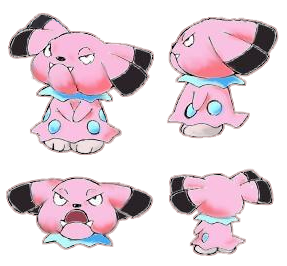 |
On a final note, some details of the Bruno code perhaps coincidentally resemble the actual event of the three Legendary Beasts encountered in the Gold and Silver versions, where the player drops down into a lower level where the Beasts reside on three platforms and will flee if approached. At the time, the Beasts were commonly believed to be dogs. While this may be a coincidence, the proximity to Gold and Silver's release may suggest yet another corruption of official Japanese information; in this case, someone may have played the Japanese game and adapted the event to the popular PokeGod rumors still in full-swing in the United States, where Gold and Silver were still largely unknown.
Hifishi
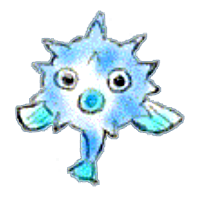 |
Hifishi seems to have been a later addition to the pantheon of Pokegods, possibly having been created later on but not really
building any momentum until close to Gold and Silver's release (and even a bit after). The initial basis for it was likely
the beta art of Qwilfish, as seen
in the image to the left. (Which, like "Pikablu", had an official name ("Buku") left ignored.
Hifishi holds the distinction of having quite possibly the most difficult and time-consuming activation code necessary for
triggering its appearance. (readable below) While all variations of the code require owning all 151 Pokemon, including pre-
evolutions simultaneously with their evolutions, some made it even more difficult by including a "No Gameshark" clause.
Usually when such a clause was provided, it was to force a much greater burdon on the player. However, most people viewed
the clause as indicative of the cheat's legitimacy; after all, cheaters never prosper, right? It was assumed the cheat
must be real if you were earning it.
|
First have 151 Pokemon then in the 6 pokemon that you carry have numbers 1-6, also you have to have ALL the unevolved forms too.
Then in all the boxes have Pokemon 7-151 ALL in order.
Then go to the entrance of the unknwon dungeon and DONOT go in instead swim in the water right of it and go up and take a right.
Then use your item finder until it finds an item.
Then use your Pokeflute and it will say HIFISHI awoke in rage, then it will get into battle and you will have the safari zone choices of
rock and bait.
Throw 5 baits, 5 rocks, and 6 balls to catch. Once you catch him, the bins will have no room, so let ALL
pokemon go accept for Mew, and then from the entrance of the unknwon dungeon with only one Pokemon use the super rod into
the water while on the bike.
Then, a Ditto will apear, catch it and it will be Pokemon No.-001, and then save the game
and beat the game with just these two pokemon and you will have ALL your pokemon back. He is classified as Type1/Rare
Type2/Water. (He comes at LV. 70.)
POKeDEX INFO: An extremely hostile water POKeMON. Uses large gills to dive deep into water. Only one has ever been confirmed,
and nobody has ever caught it.
MOVES:
Water Rapids 25/25
Whirlpool 10/10
Bubble Jet 15/15
Waterfall 5/5
Lv.75 - Title Wave 7/7
Lv.87 - Deep Dive 16/16 (Famous Attack)
Lv.99 - Typhoon 20/20
INFO
Health: 999/999
Speed - 777
Attack - 777
Defense - 777
Special - 777
|
|
While the code itself isn't any more special than many of the other codes that made the rounds of "How to catch" PokeGod sites,
the attached POKeDEX entry, moveset list, and stats caused Hifishi to stand out. Unlike most codes, this method is also
remarkably well-written and truly stands out with the attached information. These two aspects lend a sense of sincerity and
legitimacy to the code, which surely aided in its circulation.
Also unlike most other PokeGods rumored at the time, Hifishi was provided with an actual sprite. While the POKeDEX entry (as
seen to the right) has visable discrepencies from an actual in-game entry, the overall work was a notch above most other fake
sprites seen at the time, which aided in Hifishi's sense of legitimacy. As far as can be seen, the fake POKeDEX entry was
created by a Kris Sorensen
of the (now defunct) Pokemon Neon website.
It doesn't appear that Kris was attempting to mislead anyone, but, as things tended to happen, their work was interpreted as
real upon mass circulation. It is currently unknown whether the entry was made after the initial code had spread, or if they
had created the entry which then fostered a textual code. Both are rarely together, which suggests they were created separately.
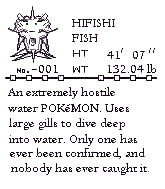 | |
Another code was circulated detailing an alternative to obtaining a Hifishi, though it was seemingly less popular and likely just one of many alternatives that pop up when a main code wouldn't work. It went as follows:
1. Have five lv100 Magikarp in your line up NOTHING ELSE (It sounds wierd. I mean, who would train a magikarp that high?
Unless you duplicate your rare candies) Then go to the Cerulean Gym.
2. Fish in the gym and win 10 battles with the Magikarp (I'm not sure if it's each)
3. Once you do that, Misty will get mad and ask you "Are you gonna battle me, or what?!" Say no, then she'll give you Hifishi,
then laugh.
|
Notably, no variation of the code without the inserted commentary appears to have been circulated, suggesting it was there
from the initial spread.
Some later lists state that Hifishi was an evolution of Gyarados, though this does not seem to be true from the beginning.
Note: If Kris Sorensen or anyone that may know them comes across this site, please feel free to contact us
if you would like to discuss Hifishi and resolve some questions on the subject.
Magazines
- Luigi
- Yoshi
Somehow, people actually thought that Yoshi was a real Pokemon though some claimed it was an "easter egg that only changed the picture" usually being said to evolve from Dragonite. Luigi was said to be the evolution of Lickitung, but both of these originated from April fools jokes (The Luigi one even being from Nintendo Power).
The Anime
|
Venustoise
Venustoise was shown on the anime series, not as a real Pokemon, but as an illusion created by Gastly in order to scare Ash's Bulbasaur
and Squirtle in "The Ghost of Maiden's Peak".
Lots of people assumed this was a real Pokemon, even though it only appeared on screen for a few seconds. To this day, Venustoise has never been,
and most likely never will be an obtainable Pokemon in any game, as it was obviously only intended to be a joke. It has never had any other
appearances in official media other than the few seconds it was on screen.
Of course, even though it was obviously not real, there was (and to an extent, still is) no shortage of rumors that supposedly told you how to
catch it. | 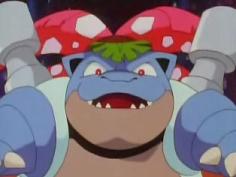
Venustoise in "The Ghost of Maiden's Peak" |
Mewthree
What commonly became known as "Mewthree" seemed to be based on the incorrect assumption that images of Mewtwo wearing armor from the first movie
were not Mewtwo, but (in most cases) an evolution called "Mewthree". These rumors started before the movie was shown or even announced in America,
people having come across the pictures from Japanese websites, or reposted on American sites with little to no context given. Taking this into
consideration it's easy to see how someone's imagination could run wild.
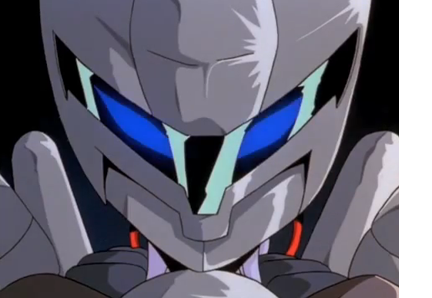 |
Even after the movie's release, however, the idea of there being an evolution of Mewtwo remained strong. Fans who had seen the movie would be quick
to point out that the armored Mewtwo was the same Pokemon, but there were also people who chose to use the name when referring to the armored version
even when they knew very well it was the same Pokemon. (something which continues to this day)
All this aside, the codes kept getting circulated and "Mewthree" kept getting mentioned.
One reason probably being that the actual pictures became
less circulated than the idea of there being a "Mewthree", regardless of what it looked like. It was also much quicker and easier to simply
copy and paste a code (as evidenced by lack of spacing in many of them) than to also copy images or other things that went along with it.
In short, the name was mostly associated with the armored Mewtwo, but not always.
|
| 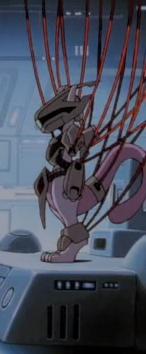 |
 |
|
There was a particular list of gameshark codes commonly being circulated which claimed to be codes for the Pokegods. The Pokemon obtained through these codes are actually different types of MissingNo, or "glitch Pokemon". For example, the Pokegod, "Mysterio" or "Millenium" is actually the glitch Pokemon "M" (also called "M block").
A contributing factor to this could be the fact that there are MissingNo. that have Kabutops fossil, Aerodactyl fossil and un-ID'ed "GHOST" sprites. Similarly to M, some of the other pokegods were different "missing number" Pokemon which take up slots in the programming but are not named "MissingNo".
Pokemon in this category include:
Anthrax
Millenium
Mysterio
Ruin
Psybir
Psybird
Doomsay
Doomsday
|